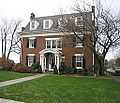Sutton Manor (New Rochelle)
| Sutton Manor | |
|---|---|
| Neighborhood | |
| Country |
|
| State |
|
| County | Westchester |
| City | New Rochelle |
| Time zone | Eastern (UTC-5:00) |
| • Summer (DST) | Eastern (UTC-4:00) |
| Area code(s) | 914 |
Sutton Manor is a historic residential district in the city of New Rochelle in Westchester County, New York. The neighborhood is located off the northern shore of Long Island Sound on Echo Bay. It was developed as an upper middle class enclave for families with heads of households employed in New York City and served as a model for the ideal suburban setting; harmonious architecture and exclusive amenities. [1]
Development
At the turn of the 18th century, most of the waterfront acreage in the northeast section of New Rochelle was owned by one of its original settlers, Huguenot Louis Guion. Another of the French refugees, Alexander Allaire, purchased much of it in 1748. [2]
The lands eventually came into the hands of James Pitcher, Commissary of Musters in the British Army, who owned it until the outbreak of the Revolutionary War. For some unknown reason his property was not confiscated and he was able to leave it to his nephew, Thomas Huntington. [3]
The portion of the property that is now Sutton Manor, came into the possession of Thaddeus Davids in the late 1830s. At the time, Davids was the head of one of the largest ink companies in the country. [4]
He built a country home in the middle of the parcel, naming it "Echo Place" to reflect its frontage on Echo Bay. He also bought an island off New Rochelle’s southern shore that still bears his name. Davids had a large family of 12 children born to 3 different wives. His second son, George W. Davids, eventually brought the family business to ruin. The company and Thaddeus Davids, individually, were forced to dispose of all assets, which resulted in the 1884 sale of Echo Place to George W. Sutton to be enjoyed as a country retreat by his family.
After Sutton’s death in 1894, the property was rented out until his heirs decided to develop the property. In 1904, George W. Sutton, Jr. formed the 'Sutton Manor Realty Company', selecting civil engineer and architect Lawrence E. Van Etten to draw up the subdivision plan of 50 home sites for the property. [5] Van Etten designed about 100 subdivisions in Westchester County between 1890 and 1950, as well as several golf courses including Wykagyl Country Club.
Historic significance
The Manor retains its original plan and amenities, including a boathouse and bathing beach, while the architecture of the homes reflect an array of stylistic choices popular during the early 1900s: Colonial Revival, Tudor Revival, Mediterranean, Arts and Crafts, Bungalow, and Art Moderne. Many of the homes were designed but prominent New York architects of the day including William Liance Cottrell and Chester A. Patterson. [6]
Sutton Manor's historical significance is also found in its association with individuals of importance to the economic and physical development of the region. With its proximity to New York City, many of the Manor's residents were involved in activities of regional, state-wide and national significance, which instigated frequent mention of the "exclusive Sutton Manor" in The New York Times. [7] Former residents include: Roland Hughes, Director of the U.S. Budget; Lee Parsons Davis, New York State Supreme Court Justice and District Attorney of Westchester County; prominent early Twentieth Century American artists Coles Phillips and Ernest Albert; Tony Award-winning actress Frances Sternhagen; and actor Thomas Carlin. [8]
In 2008, a New York State Certified Local Government grant allowed the 'Historical and Landmarks Review Board' to hire an historic preservation firm to conduct extensive research on the historic and architectural significance of Sutton Manor. For both its physical attributes and social aspects, Sutton Manor is a significant historic resource for the community and deserving of its protection through designation as a local historic district under the city code. Although not currently listed on the National Register of Historic Places, Sutton Manor meets all of the criteria and is clearly eligible for designation. [9]
Image gallery
References
- ↑ Lederer, Richard M. (1978). The Place Names of Westchester County New York. Harrison, NY: Harbor Hill Books. p. 140.
- ↑ Seacord, Morgan H. (1938). Historic Landmarks of New Rochelle. New Rochelle, New York: Huguenot and Historical Association. p. 18.
- ↑ Sutton Reynolds, Ruth (1963). The Sutton Manor Story in Historic New Rochelle. New Rochelle, New York: TheLittle Print.
- ↑ Forbes, Jeanne A. (1916). Records of the Town of New Rochelle 1699-1828. New Rochelle, New York: The Paragraph Press. p. 189.
- ↑ Larson Fisher Associates (2009). Report on Historic Survey and Analysis of Sutton Manor and Historic Resource Inventory. New Rochelle: The Historical and Landmarks Review Board.
- ↑ Larson Fisher Associates (2009). Report on Historic Survey and Analysis of Sutton Manor and Historic Resource Inventory. New Rochelle: The Historical and Landmarks Review Board.
- ↑ Sutton Reynolds, Ruth (1963). The Sutton Manor Story in Historic New Rochelle. New Rochelle, New York: The Little Print. p. 20.
- ↑ Sutton Reynolds, Ruth (1963). The Sutton Manor Story in Historic New Rochelle. New Rochelle, New York: The Little Print. p. 31.
- ↑ Larson Fisher Associates (2009). Report on Historic Survey and Analysis of Sutton Manor and Historic Resource Inventory. New Rochelle: The Historical and Landmarks Review Board.
Sources
- "New Rochelle The City of Huguenots";1926, The Knickerbocker Press, New Rochelle, NY
- "The Cruising Guide to the New England Coast"; Robert C. Duncan, W. Wallace Fenn
- "Westchester County: the past hundred years, 1883-1983"; Marilyn E. Weigold, Westchester Historical Society



